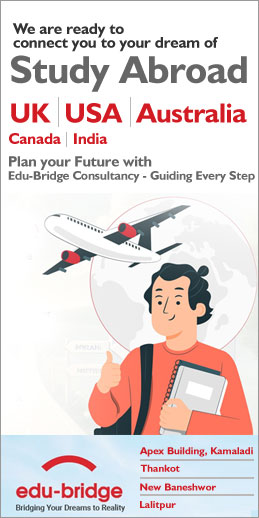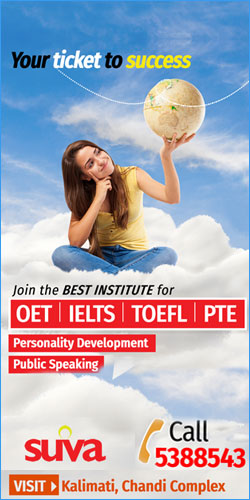Non-formal Education In Nepal

Uttam Maharjan
NON-formal education began in Nepal in 1951 AD, the year when the country was freed from the clutches of the Rana regime through the joint efforts of King Tribhuvan and the Nepalis. With the dawn of democracy, education was given prominence and made part of national development. In fact, without education, national development cannot be conceived of. In a sense, education means development. To institutionalise non-formal education, it was even encapsulated in the first five-year periodic plan (1956-1961 AD).
Non-formal education is basically concerned with literacy, post-literacy and awareness-raising programmes with a focus on continuing education, lifelong education, skill development and income generation. The non-formal education scheme is directed at certain targeted groups like illiterate adults, women and youth; out-of-school children and school dropouts; and underprivileged people like Dalits, marginalised farmers and workers.
Participatory approach
Non-formal education differs from informal education and formal education. Non-formal education is well-planned but does not follow the school system. There is no fixed time for schooling. The time can be fixed as per the convenience of participants. Likewise, there is no structured course or curriculum. Non-formal education may be free or just a nominal fee may be charged to participants. There is no age bar but it will be easier to segregate participants into homologous groups. Moreover, the non-formal education system adopts a participatory approach to learning. However, usually no degree or certificate is awarded to participants at the end of the session. In fact, the non-formal education scheme focuses on literacy and technical and vocational skill enhancement so that poor and underprivileged people can set themselves on their feet for a decent living.
The non-formal education scheme aims at imparting education equivalent to formal education through the open school system, providing continuing education for people with different skills and educational levels, embarking on an oral literacy campaign for awareness among people and imparting education equivalent to higher-level education through the open university system, among others. The non-formal education scheme is like an open school. Anybody can join it. The non-formal education scheme does not discriminate against anybody in terms of caste, gender, age, religion, language and even disabilities. So the scheme welcomes everyone from children to the elderly.
The non-formal education scheme not only makes people literate but also imparts technical and vocational training to them, which is one of its beautiful aspects. This will enable them to enhance their skills for their livelihoods as well as for their socioeconomic development. So, non-formal education encourages self-employment, enabling to deal with unemployment and poverty issues. Under the Millennium Development Goals (MDGs), every country was required to impart quality education to its people and make everyone literate by the year 2015 but the goal could not be achieved. Now the Sustainable Development Goals (SDGs) have tried to achieve the goal of education. The goal has been mentioned in SDG No. 4.
Nepal, on its part, is trying to fulfil, among others, the education-related goal of the SDGs. Accordingly, the government announced the concept paper Literate Nepal Year 2019 on December 31, 2018. The concept paper is a basic guideline for formulating policy and norms related to making the country literate by 2030 in line with the international concept of education for all. As a matter of fact, making the country literate is a daunting task. The efforts of the government alone are not adequate. The government needs cooperation, coordination and synergy from other sectors, too. In this regard, educational institutions, NGOs, civil society organisations and other stakeholders like teachers, students, parents and political parties should act in tandem to materialise the Literate Nepal campaign.
It is heartening to note that the government has adopted a policy of declaring a particular district fully literate after the district has fulfilled the required criteria. It does not require cent per cent literacy for a district to be declared fully literate. A district where at least 95 per cent of people in the 15-60 age group are literate is considered fully literate. Although one district after another has been declared fully literate, Kathmandu, the capital city of the country, is yet to be declared fully literate. The government was planning to declare the capital city a fully literate district in Chait 2076, when a nationwide lockdown was imposed on the country to stop the spread of COVID-19. Lalitpur is the first district to be declared fully literate.
The government last year announced that the country would be made fully literate in two years. Given that some districts are finding it heavy going to fulfil the literacy goal, the country cannot be declared fully literate by the time frame as announced by the government. The COVID-19 pandemic has further complicated the situation. However, the country has till 2030 to fulfil the goal. But the sooner the goal is achieved, the better so that the government can pay heed to other sectors.
Effective enrolment
The public and private sectors are involved in the non-formal education scheme. In this regard, the role of community development centres in imparting non-formal education to people ranging from children to the elderly is praiseworthy. There are community learning centres throughout the length and breadth of the country. Such centres not only conduct literacy classes but also conduct technical and vocational training programmes.
While non-formal education is going on, it is imperative to ensure that no school-going children are deprived of education. As schools will initiate the enrolment campaign, perhaps after the lockdown has been lifted, it is to be ensured that every school-going child is enrolled in one school or the other. In Kathmandu and other cities, parents can afford to enrol their children in schools. But some children living in remote and rural areas may be left out of school for various reasons like poverty and the need for doing household chores. The government should, therefore, ensure that no such children remain out of school. Let's anticipate a day when there will be no need for conducting non-formal education.
source: Uttam Maharjan , Risingnepaldaily, 9 june 2020
(Former banker, Maharjan has been regularly writing on contemporary issues for this daily since 2000. uttam.maharjan1964@gmail.com)
Posted on: 2020-06-09




























